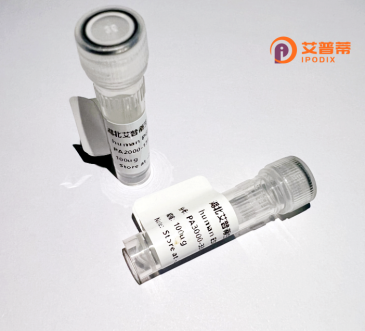
| 纯度 | >90%SDS-PAGE. |
| 种属 | Human |
| 靶点 | SCN5A |
| Uniprot No | Q14524 |
| 内毒素 | < 0.01EU/μg |
| 表达宿主 | E.coli |
| 表达区间 | 1-223 aa |
| 活性数据 | MANFLLPRGTSSFRRFTRESLAAIEKRMAEKQARGSTTLQESREGLPEEEAPRPQLDLQASKKLPDLYGNPPQELIGEPLEDLDPFYSTQKTFIVLNKGKTIFRFSATNALYVLSPFHPIRRAAVKILVHSLFNMLIMCTILTNCVFMAQHDPPPWTKYVEYTFTAIYTFESLVKILARGFCLHAFTFLRDPWNWLDFSVIIMAASVLGTLFFPMSIQATSTS |
| 分子量 | 51.8 kDa |
| 蛋白标签 | GST-tag at N-terminal |
| 缓冲液 | PBS, pH7.4, containing 0.01% SKL, 1mM DTT, 5% Trehalose and Proclin300. |
| 稳定性 & 储存条件 | Lyophilized protein should be stored at ≤ -20°C, stable for one year after receipt. Reconstituted protein solution can be stored at 2-8°C for 2-7 days. Aliquots of reconstituted samples are stable at ≤ -20°C for 3 months. |
| 复溶 | Always centrifuge tubes before opening.Do not mix by vortex or pipetting. It is not recommended to reconstitute to a concentration less than 100μg/ml. Dissolve the lyophilized protein in distilled water. Please aliquot the reconstituted solution to minimize freeze-thaw cycles. |
1. **文献名称**: "Cardiac sodium channel mutations in patients with long QT syndrome, an inherited cardiac arrhythmia"
**作者**: Wang Q, et al.
**摘要**: 该研究鉴定了SCN5A基因突变与长QT综合征3型的关联,首次证明了突变导致心脏钠电流延长,引发心律失常。
2. **文献名称**: "Genetic basis and molecular mechanism for idiopathic ventricular fibrillation"
**作者**: Chen Q, et al.
**摘要**: 发现SCN5A基因功能缺失突变与Brugada综合征相关,解释了钠通道电流减少导致异常心电图与室颤风险。
3. **文献名称**: "Crystal structure of an orthologue of the NaChBac voltage-gated sodium channel"
**作者**: Payandeh J, et al.
**摘要**: 通过解析细菌同源钠通道结构,推测SCN5A的电压感应与离子通透机制,为人类心脏钠通道功能研究提供结构基础。
4. **文献名称**: "SCN5A mutations associated with dilated cardiomyopathy alter cardiac sodium channel kinetics"
**作者**: McNair WP, et al.
**摘要**: 揭示了扩张型心肌病相关的SCN5A突变通过改变钠电流动力学,导致心肌细胞电活动异常与结构重构。
---
以上文献涵盖SCN5A的致病突变、结构机制及与疾病的关联,适用于深入研究钠通道功能与心脏病理学。
The SCN5A gene encodes the α-subunit of the human voltage-gated sodium channel NaV1.5. which plays a critical role in initiating and propagating cardiac action potentials. This transmembrane protein facilitates rapid sodium ion influx during the depolarization phase, essential for maintaining normal electrical activity in cardiomyocytes. Structurally, NaV1.5 consists of four homologous domains (DI-DIV), each containing six transmembrane segments, with a pore-forming loop and voltage-sensing regions. Mutations in SCN5A are linked to various cardiac arrhythmias, including long QT syndrome type 3. Brugada syndrome, and progressive cardiac conduction defects, often due to altered channel gating, expression, or trafficking. Recombinant SCN5A protein, produced via heterologous expression systems (e.g., HEK293 or CHO cells), enables detailed biophysical and pharmacological studies. Researchers use it to dissect mutation-specific effects on channel function, screen potential antiarrhythmic drugs, and model disease mechanisms. Its applications extend to drug toxicity assessments, particularly for compounds inadvertently inhibiting cardiac sodium currents. Despite challenges in achieving native-like post-translational modifications in vitro, recombinant NaV1.5 remains indispensable for advancing precision medicine in channelopathies and improving therapeutic strategies targeting sodium channel dysfunction. Ongoing studies also explore its roles in non-cardiac tissues, such as the gut and peripheral neurons, broadening its biomedical relevance.
×